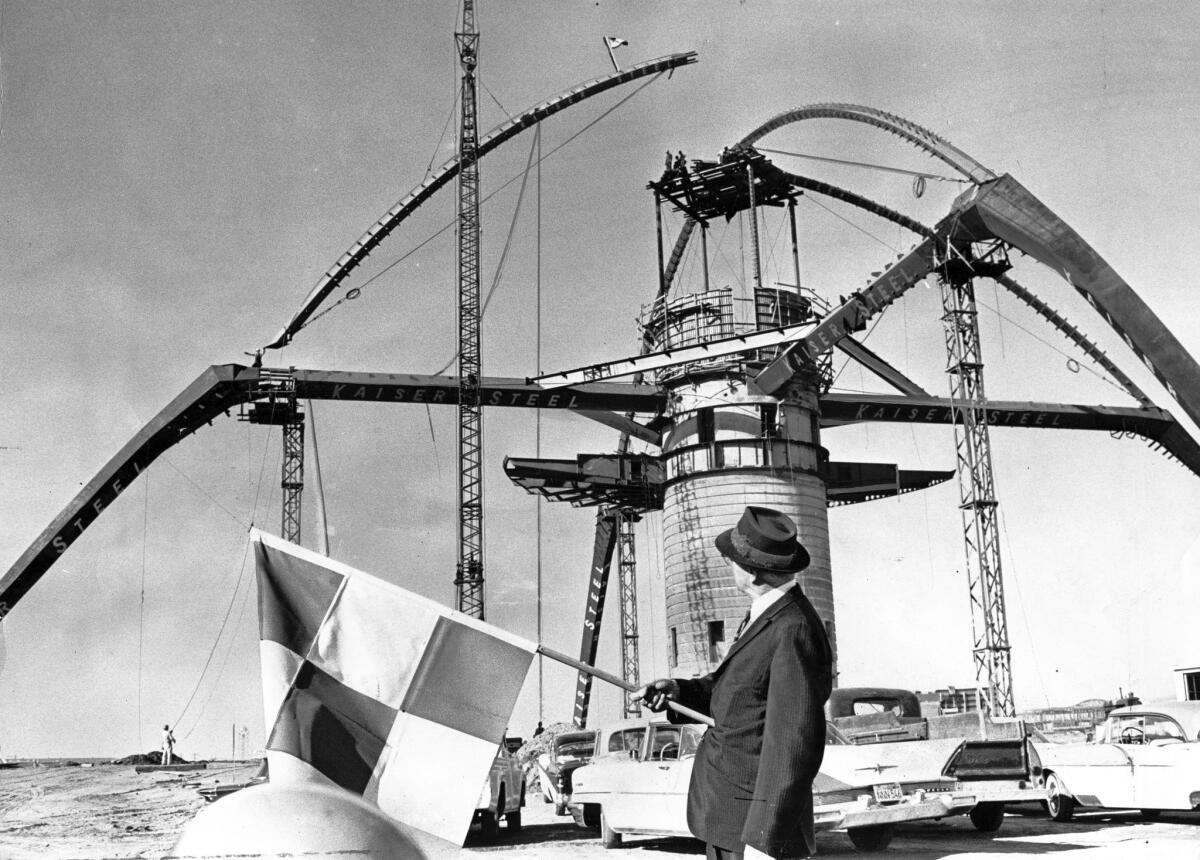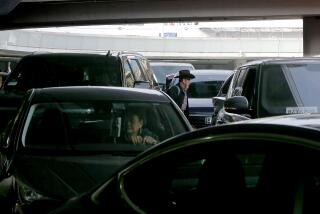California Retrospective: How LAX’s Theme Building became an iconic symbol of Los Angeles

For many in Southern California, Thanksgiving means passing through Los Angeles International Airport.
In 1928, the city of Los Angeles selected Mines Field, near Inglewood, as the city’s airport. Up until then, Los Angeles had been served by several private airfields.
A story in the June 8, 1930, Los Angeles Times reported:
Southern California’s airmen — commercial, Army, Navy and Marines — brought their planes and nerves to Los Angeles yesterday to give a crowd of 25,000 persons an afternoon of thrills and demonstrations of aviation advancement as a feature of the dedication ceremonies at the Municipal Airport.
Today from 10 a.m. to 3:30 p.m. the fliers will go aloft again for the free entertainment of the field visitors and to conclude the exercises that formally mark the three-year transition of the city’s modern sky harbor from a hay field to one of the most modern ports, located on the Inglewood-Redondo Boulevard, three miles south of Inglewood.…
Besides the service planes from San Diego, groups of National Guard, March Field, Navy Reserve and Army Reserve craft swooped down the field’s oiled runway in quick succession. Before landing they flew in formations developed through years of aerial tactical maneuver experiments.
When these ships were grounded, alongside 90 commercial planes of every description, the Los Angeles Fire Department Band, Santa Monica Municipal Band and American Legion Drum and Bugle Corps presented a program of music and drills.
NEWSLETTER: Get the day’s top headlines from Times Editor Davan Maharaj >>
Then a wreath was delivered by Lt. Bud Campbell, at the controls of the Goodyear blimp Volunteer, to Miss Viola Peers, who placed it on the propeller of a decorated plane in front of the administration building, marking officially the port dedication.
Mines Field remained a fairly sleepy place until after World War II, when air travel took off and L.A.’s population — and its global importance — increased.
Perhaps the best marker of those days is the space-age Theme Building.
In 1960, the Theme Building’s last girder was placed, under the watchful supervision of Airport Commissioner Don Belding.
The Times reported:
With quarter-inch precision, Roy Milne dropped a 10-ton steel arch into place Tuesday to complete the steel framework of the new Theme structure at the new International Airport.
He manipulated seven hand controls and three foot brakes in the cab of a crane to ease the monstrous piece of steel literally into the lap of a waiting steelworker perched 80 feet above him.
Five minutes later, three workers at the peak of the structure, 135 feet up, grabbed the other end and eased it into place.
The $2.2-million structure was “flagged in.”
An American Flag, in fact, rode up on the beam to signal the completion of high steel work. This was a variation of an old tradition of steel builders. They formerly marked the last piece of steel with a small, red flag. They changed the flag to the national ensign when “red” took on political implications.
The Star-Spangled Banner became disconnected from its slender mast as the beam dropped into place and a worker climbed casually out on the sloping ridge of the steel to tie it back in place.
The structure will house a restaurant, “floating” like a satellite 80 feet above the airport, and on top of the glassed eating facility will be an observation deck with 360-degree view of the $50-million jet-age airport.
The Theme Building is now one of L.A.’s most iconic buildings. As The Times wrote in 2010:
Part spaceship, part flying saucer, the unusual-looking circular structure was sometimes mistaken as the LAX control tower. A year after it rose, the futuristic animated show “The Jetsons” aired for the first time.
Over the years, the Theme Building became as much an iconic symbol of Los Angeles as the Hollywood sign.
That was the plan, according to the man who directed the design of the $2.2-million structure through a partnership with three major architectural firms: Pereira & Luckman and Associates, Welton Becket and Associates, and Paul R. Williams.
Architect Gin Wong set out to create a futuristic building that would both reflect its relationship with aviation and stand the test of time.
It did the latter for 47 years. But in 2007 a half-ton chunk of stucco fell from the upper portion of the eastern arch and smashed into pieces when it hit the restaurant roof. That prompted a three-year, $14.3-million repair and seismic-upgrading project financed by airport revenue funds.
The observation area is still open at the building, but the restaurant closed last year.
ALSO
Despite California’s budget surplus, unions eye tax hikes
Bullet train faces new scrutiny after release of report predicting higher costs
California’s hard-hit water districts will get a chance to ask regulators for relief
More to Read
Start your day right
Sign up for Essential California for news, features and recommendations from the L.A. Times and beyond in your inbox six days a week.
You may occasionally receive promotional content from the Los Angeles Times.






